Ceramics
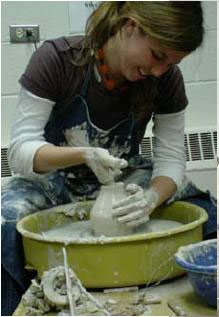
General Information:
Clay is most dangerous when it is in a dry state and the dust can be inhaled. Silica is an ingredient found in a wide variety of materials used by artists and craftspeople, including sand, quartz, foundry molding sand (silica flour), sandstone, calcined diatomaceous earth, granite, flint, many abrasives, slate, clays, fused silica, feldspar and many carving stones. Amorphous or noncrystalline silica includes such materials as diatomaceous earth and cabosil.
Inhalation of large quantities of silica during the mixing of powdered clay is very hazardous and can cause silicosis or “potters rot” after years of exposure. Silicosis takes at least 10 years to develop and entails symptoms such as shortness of breath, dry cough, emphysema, and high susceptibility to lung infections such as tuberculosis. Skin contact and ingestion pose no significant hazards.
Inhalation of large quantities of China clay powder is moderately hazardous, causing kaolinosis, a disease in which the lungs becomes mechanically clogged by the clay. China clay may also cause silicosis if it contains free silica.
Asbestos is highly toxic by inhalation and possibly by ingestion. It may cause asbestosis, lung cancer, mesothelioma, stomach cancer and intestinal cancer. Talcs are often contaminated with asbestos.
Sand, perlite, grog, and vermiculite contain free silica sand are, therefore, highly toxic by inhalation.
Sanding dry clay can create a problem through the inhalation of free silica.
Handling wet clay:
Molds that grow in wet clay may cause respiratory problems similar to pneumonia and asthma-type allergies. Respiratory problems can also result from inhalation of powders that develop when aged clay dries. The molds, which can contribute to the workability of the clay, can cause skin problems, particularly if there is a pre-existing dermatitis.
Handling cold wet clay, such as when throwing clay, can cause abrasion and drying of the hands, particularly the fingertips. This is a result of the mechanical friction or rubbing of the clay particles on the hands, the oil absorbing ability of the clay, and the harmful effects from prolonged exposure to cold water.
Mechanical/Physical Safety Hazards:
The use of a kickwheel for throwing clay is a mechanical hazard since the moving parts can cause cuts and abrasions, particularly with children.
Small pieces of wet clay that collect on the floor and bench can dry and becomes pulverized, producing an inhalation hazard due to the presence of free silica. This also applies to the process of reconditioning clay or grog.
Glazes also pose health and safety concerns, due to the presence of toxic heavy metals, such as cobalt, hexavalent chromium, nickel, titanium and vanadium. These powdered glazes are respiratory hazards, in addition to being carcinogenic and teratogenic.
Prevention:
- Control exposures to crystalline silica by substituting premixed glazes for those that require mixing of dry powders; if premixed glazes are not feasible, intall properly designed local exhaust ventilation to capture airborne contaminants at the point of generation.
- Install an effective local exhaust ventilation at the wedging table to reduce potential for exposure to silica, and use wet methods to clean the table or use a vacuum cleaner equipped with a HEPA filter.
- Clean floors, table and other surfaces thoroughly and regularly to reduce potential exposure to crystalline silicia — using wet methods and or a HEPA vacuum cleaner will help prevent dust from becoming airborne.
- Launder student aprons frequently to remove dry clay, a likely source of airbone silica.
- Implement an effective chemical hazard communication program to ensure that teachers and students are aware of the hazards of materials they are using.
Resources:
- Crystalline Silica Primer, US Department of the Interior, US Bureau of Mines, Branch of Industrial Minerals, (1992)
- A Guide to Working Safety with Silica, U.S. Department of Labor, National Institute of Occupational Safety and Health
- Health Effects of Occupational Exposure to Respirable Crystalline Silica, NIOSH Hazard Review, April 2002
- Silica and Silicosis, OSHA Silica Advisor
Drawing

Chemical Hazards:
Drawing materials are pigments (raw color) suspended in a vehicle (carrier) such as wax, inert minerals (pastels, conte, crayons, chalks), and liquids (solvent based inks and marking pens). Pencils contain “leads” made of graphite and clay or pigmented clay/binder mixtures (colored pencils).
Drawing inks may contain hazardous dyes and solvents. Skin contact should be avoided.
Dry pastels release respirable-sized pigment and other vehicle particles. Oil pastels contain small amounts of oils and waxes which keep dust particles from becoming airborne and therefore can be used more safely.
The hazards of drawing arise due to exposure to the pigments, vehicles or solvents. The most common exposure to these chemicals is through inhalation by working with raw powdered pigments such as dusty chalks or pastels, by inhaling the dust that accumulates and circulates from drawing materials in the drawing room. Charocal has no significant hazards.
Prevention:
- Minimize your inhalation of dusts when handling dry pigments.
- Do not work near a draught or fan that will blow them about.
- Do not eat drink or smoke when working with drawing materials.
- Wear dedicated work clothing and launder frequently.
- Keep your work areas clean by wet-mopping to avoid disturbing settled dust.
- If possible, work with pigments that you have first wetted into a paste or liquid.
- Store pigments in sealed, easy to open containers.
- Protect hands and skin:
- Wear gloves, especially if you have cuts or abrasions.
- Use a barrier cream. Barrier creams should be applied about 30 minutes before starting work.
- Do not allow your hands to get caked in materials – wash your hands frequently and re-apply barrier cream.
- Keep your hands away from your face and eyes.
Painting
Painting materials and the materials used to cleanup after painting can contain hazardous materials. These materials require the users to take precautions to control their exposures. Please contact University Safety and Assurances if questions regarding controlling exposures.
Alternative Painting Methods
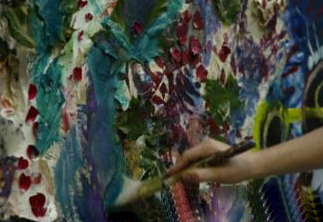
Chemical Hazards
Tempera Paints are pigments suspended in emulsions of substance such as egg, gum casesin and wax. Preservatives are added to kill microorganisms which would feed on the vehicles.
Encaustics are dry pigments suspended in molten white refined wax such as beeswax, paraffin or carnuba combined with drying oils, venice turpentine, and natural resins. Working with dry pigments is very hazardous. Heating waxes can release irritating wax decomposition products such as acrolein, formaldehyde and other aldehydes. Torching the wax surface can also cause pigments to fume.
Consumer Oil Paints and Enamels contain pigments, fillers and a variety of solvents. A common solvent for these paints is paint thiner.
Consumer Latex Paints are primarily pigments and water emulsions of various plastic resins. Most also contain 5-15% solvents. Sometimes these solvents are the highly toxic glycol ethers which can be absorbed and inhaled.
Oil Painting
Chemical Hazards

Commonly-used paints, like oil, acrylic, watercolor and gouache, may contain heavy metals such as cadmium, chromium, and lead, which can be hazardous to your health and the environment. Also, oil paints contain solvents and require cleanup with solvents, such as turpentine, mineral spirits, or other paint thinners. Oil paints, resins, and solvents each pose fire safety hazards.Many of these are corrosive to the skin and cause irritation of the respiratory tract and mucous membranes. They also produce allergic reactions. Precautions when using these materials are imperative in order to reduce problems.
Unless the pigments listed below are used, the biggest hazard in oil painting generally comes from the use of turpentine or other toxic solvents.
Toxic inorganic pigments include:
- Naples Yellow (Antimony)
- Cobalt Violet (Arsenic)
- All Cadmium Pigments (Cadmium)
- Chromium Oxide Green, Veridian, Chrome Yellow, Zinc Yellow, Strontium Yellow (Chromium)
- Cobalt Blue, Cobalt Green, cobalt Yellow, Cerulean Blue, Cobalt Violet (Cobalt)
- Flake White, Naples, Yellow, Chrome Yellow (Lead)
- Manganese Blue, Raw Umber, Burnt Umber, mars Brown, Manganese Violet (Manganese)
- Vermillion, Cadmium Vermillion Red (Mercury)

Organic Solvents:
Organic solvents are a class of carbon-based liquids, commonly a component of oil-based paints, printing inks, wood finishes and varnishes. Organic solvents such as laquer thinner are used in printmaking to remove ink from the plates.
Organic solvents vary widely in their properties and toxicity. They are often volatile, meaning that they evaporate quickly, giving off vapors that may be harmful if inhaled. Some volatile solvents, like ethyl ether, can have an anesthetic effect on the nervous system. Other solvents may cause long-term liver damage or may otherwise impact the internal organs or nervous system over a long period of time. Many organic solvents are also highly flammable. Their vapors can ignite easily, even at some distance from where the solvent is being used.
Wear gloves and goggles to protect your skin and eyes when handling solvent-based products. Consult the MSDS for the solvent you’re using to make sure the type of glove you choose will protect against the particular solvent being used. If the MSDS warns against an inhalation hazard, you must work with local exhaust ventilation.
Watercolor Painting
Water-based paints include water color, acrylic, gouache, tempera and casein. Water is used for thinning and cleanup.
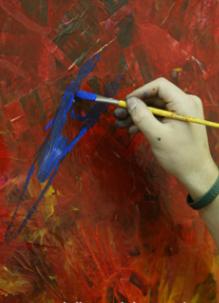
Chemical Hazards:
Watercolors:
Watercolors (dry cakes) are composed of pigments, preservatives (often paraformaldehyde) and binders such as gum arabic or gum tragacanth. Liquid watercolors may also contan water, glycerine, glucose and other materials. Both liquid and dry watercolors may give off small amounts of formaldehyde, but generally need no exhaust ventillation.
Gouache is an opaque watercolor which contains pigments, gums, water, preservatives, glycerine, opacifiers and other ingredients. The opacifiers may be chalk, talc or other substances. Formaldehyde may be used as a preservative.
Acrylic Paints:
Acrylic paints contain a small amount of ammonia. Some sensitive people may experience eye, nose and throat irritation from the ammonia. Acrylics and some gouaches contain a very small amount of formaldehyde as a preservative. Only people already sensitized to formaldehyde would experience allergic reactions from the trace amount of formaldehyde found in acrylics. The amounts can vary from manufacturer to manufacturer.
Acrylic paints (Water-Based Emulsions) are composed of synthetic acrylic resins and pigments with many additives usually including an almmonia-containing-stabilizer and formaldehyde preservative. The small amounts of ammonia and formaldehyde released during drying can cause respiratory irritation and allergies.
Acrylic Paints (Solvent-Based) are synthetic acrylic resins and pigments dissolved in solvents. The solvents should be identified and ventilation sufficient to keep the solvent’s concentration at a safe level should be provided.
Casein Paints:
Casein paints use the protein casein as a binder. While soluble forms are available, casein can be dissolved in ammonium hydroxide which is moderately irritating by skin contact and highly irritating by eye contact, ingestion, and inhalation.
Printmaking
Chemical Hazards
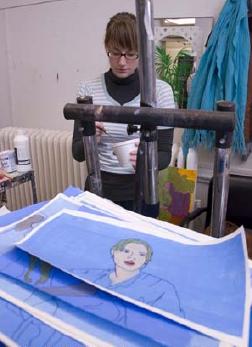
Organic Solvents:
Organic solvents are a class of carbon-based liquids, commonly a component of oil-based paints, printing inks, wood finishes and varnishes. Organic solvents such as laquer thinner are used in printmaking to remove ink from the plates.
Organic solvents vary widely in their properties and toxicity. They are often volatile, meaning that they evaporate quickly, giving off vapors that may be harmful if inhaled. Some volatile solvents, like ethyl ether, can have an anesthetic effect on the nervous system. Other solvents may cause long-term liver damage or may otherwise impact the internal organs or nervous system over a long period of time. Many organic solvents are also highly flammable. Their vapors can ignite easily, even at some distance from where the solvent is being used.
Corrosive Materials:
The printmaking process uses strong acids, like hydrochloric (muriatic) and nitric acid, to etch designs into metal plats. Corrosives may be either acids with a very low pH, or caustics (bases) with a very high pH.
Corrosive materials are hazardous because they burn, irritate or damage tissue on contact. Highly concentrated, strong corrosive materials, such as the etching solution used in printmaking, can cause severe, permanent injury to skin tissue. Concentrated corrosives also give off vapors which can damage the respiratory tissue and mucous membranes if inhaled.
Prevention:
Organic Solvents:
Wear gloves and goggles to protect your skin and eyes when handling solvent-based products. Consult the MSDS for the solvent you’re using to make sure the type of glove you choose will protect against the particular solvent being used. If the MSDS warns against an inhalation hazard, you must work with local exhaust ventilation.
Whenever possible replace highly flammable, toxic or suspect and known human carcinogenic solvents with less toxic solvents. Especially avoid the use of ethyl ether, benzene, carbon tetrachloride and chloroform.
Corrosive Materials:
Use concentrated corrosive materials only in well-ventilated areas. When diluting acids, add acid to the water, not the reverse. Pouring water into concentrated acid causes a violent reaction — spattering, splashing and sudden build-up of heat. Be cautious of incompatibilities: some corrosives are oxidizers in their concentrated form (e.g. ntiric and perchloric acids) and will react strongly with organic materials (e.g. paint thinner). Also, some acids and bases may be incompatible with each other. Concentrated corrosive materials will quickly penetrate most clothing materials and injure your skin, so if you accidentally splash yourself, remove any affected clothing and rinse the skin liberally for at least 15 minutes. Make sure there is an eyewash station nearby before beginning work with corrosives. Eyewash stations are usually tagged to show the last date of inspection, but you can also check it yourself to make sure it provides clean, rust-free water.
Goggles are a must whenever working with corrosives, and corrosive-resistant gloves are advisable. If you’re using highly concentrated corrosives and there is a possibility of splashing or splattering, you should use corrosive-resistant long-sleeved gloves and a face shield over your goggles. If you must work with concentrated corrosives such as fuming nitric acid, do so only under good local exhaust ventilation.
Whenever possible replace highly concentrated corrosives with more dilute solutions.
(Information condensed from “Art Hazards” by Dan Sweetman, UW-LaCrosse)
Sculpture and Woodworking
Metal Casting Safety
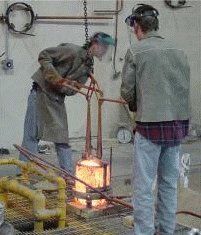
- Wear eye protection, gloves, spats (covering top of feet), and thick clothing protecting all exposed skin on arms and legs. NO polyester or synthetic clothing.
- Clear all objects not involved in pouring from the area.
- Clamp or weight up molds that require it.
- Metal added to heat must be free of moisture and impurities.
- Metal added to heat during melt must be preheated.
- Skimmers and other melting tools must be preheated before use.
- Move Slowly while removing crucible from furnace and moving to mold.
- USE COMMON SENSE!
Do not look into exhaust during operation. - Inspect crucibles before use.
- Inspect propane lines.
- Use outdoors only.
- Wear respiratory protection while melting copper-base alloys (brass, bronze).
Additional Resources:
- CSHEMA 2001 Presentation: “Recommended Standard Operating Procedure for Iron Pouring from a Cupola Furnace in the Art Studio

- Welding Safety
- Lockout-Tagout (LOTO) Program
- Machine Guarding Information
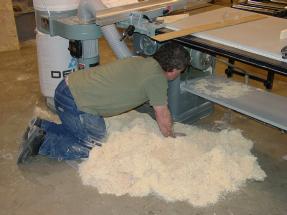
Woodworking
Many woods can cause skin irritation and allergies. Some of these woods include South American boxwood, cocobolo, ebony, American and African mahogany, mansonia, rosewood, walnut, East Indian and other satin woods and Western Red Cedar.
Chronic inhalation of sawdust can cause chronic respiratory diseases. Cocobolo, ebony, African mahogany, mansonia, rosewood, and satinwood can cause respiratory irritation and allergies. Beech, iroko, Western Red Cedar, and teak can cause severe asthma. South American boxwood, cork oak, and redwood can cause an acute illness resembling pneumonia.
Plaster Molds and Casts
Plaster of Paris (calcium sulfate) is irritating to the eyes and slightly irritating to the respiratory system.
Heat builds up when plaster sets and can be dangerous enough to cause serious burning when casting parts of the human body.
Theatre Safety
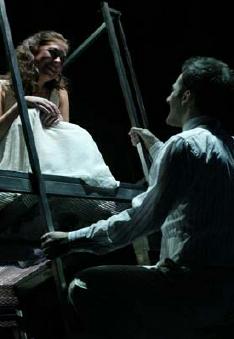
Guardrail Systems in Theatre Catwalks
Many theatre catwalks, like we have at UWM, do not have a standard railing system (e.g., toeboard, midrail, standard rail); rather, many just have a top rail and perhaps a toeboard.
The 2002 Wisconsin Enrolled Commercial Building Code, Chapter 10 (Means of Egress) addresses the issue. Section 1003.2.12 does offer exceptions to the standard rail system for theatre occupancies:
Specifically, 1003.2.12:
- Exception: Guards are not required for the following locations: #5: At elevated walking surfaces appurtenant to stages and platforms for access to and utilization of special lighting or equipment.
Although the building code provides an exception, from a safety perspective, fall protection methods must still be utilized.
Students and workers must follow good work practices including:
- Ensuring the catwalk is structurally sound and capable of supporting its design loading.
- Inspecting the catwalk routinely including all welds and bracing members.
- Being aware of the hazards of catwalks, especially in the presence of corrosive materials.
- Observing catwalk conditions and reporting any defects immediately.
- Use a harness and lanyard system for fall protection